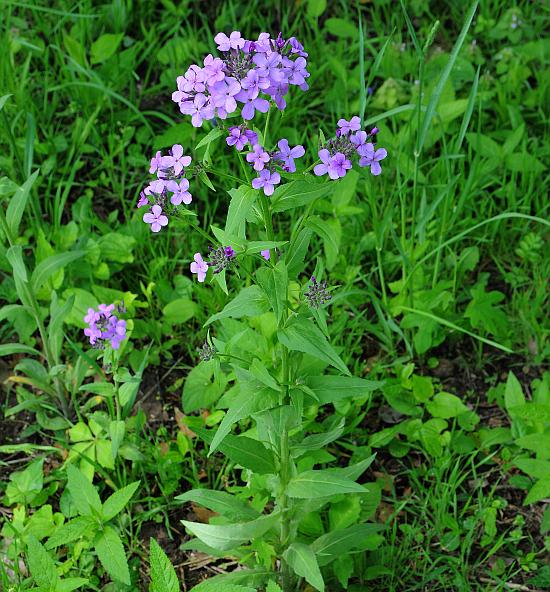Hesperis matronalis L.
Dame's Rocket

Introduced
CC = *
CW = 3
MOC = 40
© SRTurner
Hesperis matronalis L.Dame's Rocket | |
 |
Introduced CC = * CW = 3 MOC = 40 |
© SRTurner |
|
Family - Brassicaceae Habit - Biennial or perennial forb. Stem - Erect, to 1.2 m, branched from the base and usually also in the upper half, pubescent with 2-branched and unbranched hairs, sometimes also with very sparse glands.
Leaves - Alternate and basal, 4-20 cm long, the lower leaves petiolate, the upper ones often sessile, not clasping, the leaf blades lanceolate to ovate-lanceolate, the margins toothed, pubescent on the upper surface with unbranched hairs and on the undersurface mostly with 2-branched hairs.
Inflorescences - Panicles, the lower branches subtended by reduced leaves.
Flowers - Sepals 5-8 mm long, ascending, oblanceolate. Petals 15-25 mm long, not lobed, pink to purple, rarely white. Styles 3-4 mm long. Stigma lobes decurrent.
Fruits - Ascending siliques, straight to slightly arched upward, 6-10 cm long, more than 10 times as long as wide, linear, circular in cross-section, not beaked except for the persistent style, each valve with a midnerve and sometimes 2 lateral, longitudinal nerves, dehiscing longitudinally. Seeds in 1 row in each locule, 2.1-3.0 mm long, oblong-elliptic in outline, somewhat flattened, usually with narrow wings at both ends, the surface with a fine, netlike or honeycomb-like pattern of ridges and pits, sometimes roughened, reddish brown. Flowering - May - June. Habitat - Fields, roadsides, open disturbed areas. Origin - Native to Europe. Lookalikes - None. Other info. - This is one of the showier mustards, frequently cultivated for its large and fragrant flowers. It is found in scattered locations across most of Missouri and the continental U.S. It is easily recognized by its upright stature, lance-shaped leaves, and large, four-petaled flowers. The flowers are usually purple but can range to pink and even white. Though frequently escaping cultivation, the plant is usually not aggressive, and escaped populations often do not persist for many years. Photographs taken at Klondike County Park, St. Charles County, MO, 5-13-2013, and Faust County Park, St. Louis County, MO, 4-30-2019 (SRTurner). |